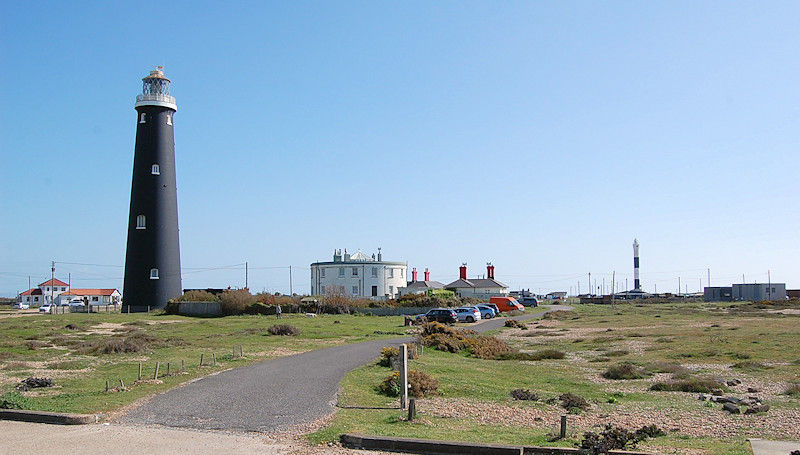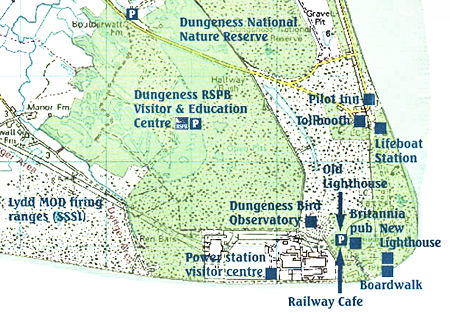Dungeness
It is formed largely of a shingle beach in the form of a foreland, between New Romney, Lydd and Camber on Romney Marsh and shelters a large area of the low-lying land Romney Marsh.
The New York Times once stated
'if Kent is the Garden of England,
Dungeness is the back gate'
![]() Explore Places on Dungeness
Explore Places on Dungeness
![]() Guided Tour Dungeness
Guided Tour Dungeness
![]() Town Council
Town Council
![]() Village Website
Village Website
![]() Reference and more information
Reference and more information
![]() The Locals Talk about Dungeness
The Locals Talk about Dungeness
If you plan to visit Dungeness, please read this notice

Dungeness lies at the southernmost point of Kent and the area represents the most diverse and extensive example of stable vegetated shingle in Europe.
It has been said that Dungeness is like Marmite, you either love it or hate it. The landscape certainly divides people – a broad, echoing flatness with the nuclear power stations on one side, the shingle dipping into the sea on the other and railway carriages turned into quaint and sstrange looking dwellings.
The stark wild beauty and distinctive character of this shingle desert engenders feelings of awe, wonder and curiosity.
Dungeness is a unique environment that has been designated as a Site of Special Scientific Interest and as a result has captured the imagination of photographers and artists for years. The landscape is so barren that it has become a well-known landmark and unlikely tourist spot, attracting one million visitors annually.
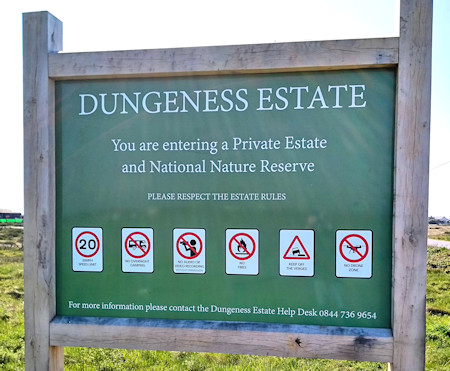
Dungeness is the largest cuspate foreland in Britain, and globally very unusual because it is formed predominantly of flint shingle. Beaches ridges date from about 5500 years BP and the best-preserved sequence can be traced from the 8th century AD.
In addition to exposed shingle covering about 2158 ha, there are also buried shingle banks, which underlie a further 1150 ha.
Other large shingle structures such as Chesil Beach, Spey Bay and Orfordness are comparable in terms of the length of coastline that they occupy, but they do not contain the enormous volume of shingle stored in the shingle ridges at Dungeness.
The feature is often regarded as an integral part of a system of former barrier beaches that extend about 40 km from Fairlight in the west to Hythe in the east.
Other well-known cuspate forelands, such as the Darss peninsula on the German Baltic coast, Cape Kennedy in Florida, Cabo Santa Maria on the Portuguese Algarve coast and Cabo Rojo on the Mexican coast, rival and exceed Dungeness for size, but Dungeness is unique globally because it has a number of features that are absent or less well developed elsewhere.
Dungeness is formed almost entirely of flint shingle and is a relatively advanced form of cuspate foreland, much of the shingle having been re-distributed from barrier beaches to form a ness with a particularly acute angle between its two main shorelines. It has long been recognized internationally as a major example of its type.
For instance, as early as 1913, de Martonne described it as ‘le type le plus connu: la pointe de Dungeness'.
Standard texts from all parts of the world refer to Dungeness as the best-known example of a cuspate foreland (e.g. Holmes, 1944, 1965; Zenkovich, 1967; Bird, 1968, 1984; Paskoff, 1985).
No area inland of beaches to have been occupied and land-claimed over so long a period of time (about 1200 years) has been documented so intensively as Dungeness, and the documentary record extends over a far longer period than for any comparable site.
![]() reference and more information
reference and more information
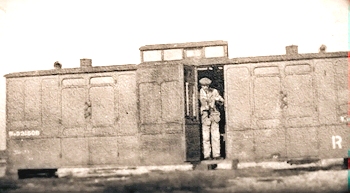
Railway Carriage in the 1920s, which like many
others, were used as homes (ack 32.)
The area is dominated by two nuclear power stations, one currently being decommissioned; two lighthouses and is at the end of the line for the Romney, Hythe and Dymchurch Railway.
There is a scattered collection of dwellings; some of the homes, small wooden houses in the main, many built around old railway coaches (see picture bottom right), are owned and occupied by fishermen. See Plan of Dungeness Estate
Some are occupied by people trying to escape the pressured outside world. The shack-like properties have a high value on the property. Perhaps the most famous house is Prospect Cottage, formerly owned by the late artist and film director Derek Jarman.
Dungeness is an important ecological site with flora and fauna unique to its shingle , which encompasses a RSPB reserve and is home to 600 species of plants, which is a third of all plants found in the UK. The site represents the most diverse and extensive example of stable vegetated shingle in Europe.
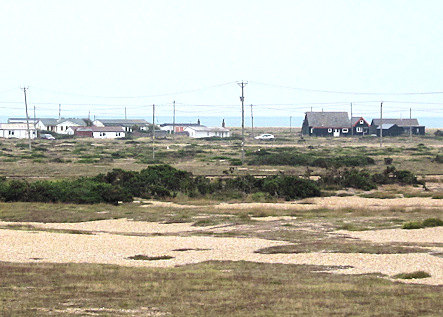
The Landscape of Dungeness
It is also one of the best places in Britain to find insects such as moths, bees and beetles, and spiders; many of these are very rare, some found nowhere else in Britain. The short-haired bumblebee, Bombus subterraneus, was last found in the UK in 1988, but has survived in New Zealand after being shipped there more than 100 years ago. It is to be reintroduced at Dungeness.
The flooded gravel pits on Denge Beach, both brackish and fresh water, provide an important refuge for many migratory and coastal bird species. The RSPB has a bird sanctuary there and every year thousands of bird watchers descend on the peninsula to catch a glimpse of a rare bird from the bird observatory.
Nick Levinson describes Dungeness:
"Dungeness is a big attraction to visitors,artists, photographers, fishermen, walkers and consumers of sea food. It is a peculiar place, quite different from the lush inland pastures as it is composed of the largest shingle beach in Europe, a peninsular built-up over about six thousand years by the sea. Despite being one of the driest parts of the United Kingdom, it is a haven for wild flowers and birds. The Southern tip has a curious colony of black tarred fishermen‟s huts and winching equipment for hauling their boats up on the beach and the strange little dwellings, often incorporating old railway carriages, erected before the days of planning permission."
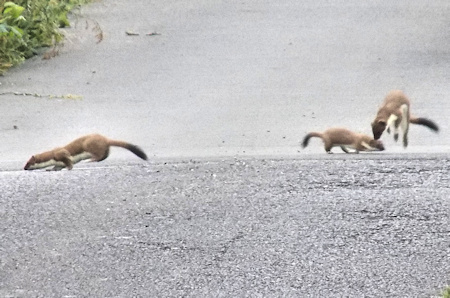
Stoats Playing at Dungeness
One of the most remarkable features of the site is an area known as 'the patch' or, by anglers, as 'the boil'. The waste hot water and sewage from the Dungeness nuclear power stations are pumped into the sea through two outfall pipes, enriching the biological productivity of the sea bed and attracting seabirds from miles around.
The flooded gravel pits on Denge Beach, both brackish and fresh water, provide an important refuge for many migratory and coastal bird species. The RSPB has a bird sanctuary there and every year thousands of bird watchers descend on the peninsula to catch a glimpse of a rare bird from the bird observatory.
The flooded gravel pits on Denge Beach, both brackish and fresh water, provide an important refuge for many migratory and coastal bird species. The RSPB has a bird sanctuary there and every year thousands of bird watchers descend on the peninsula to catch a glimpse of a rare bird from the bird observatory.
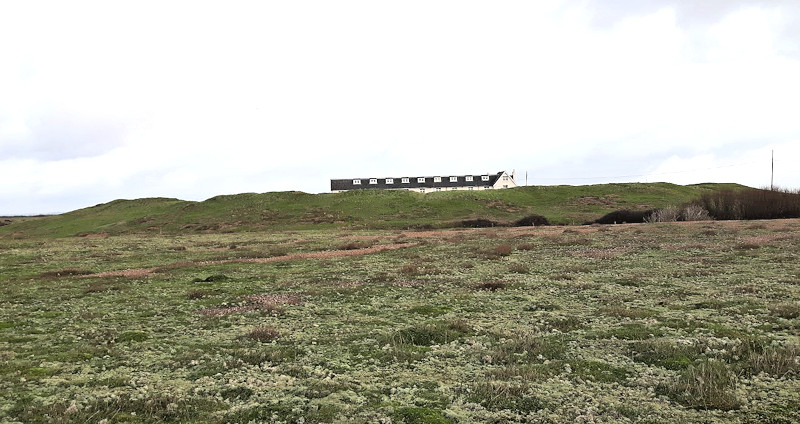
Dungeness Redoubt today
(with the old Coastguard cottages within its boundary)
One of the most remarkable features of the site is an area known as 'the patch' or, by anglers, as 'the boil'. The waste hot water and sewage from the Dungeness nuclear power stations are pumped into the sea through two outfall pipes, enriching the biological productivity of the sea bed and attracting seabirds from miles around.
Beach fishing is popular at Dungeness, with the area being a nationally recognised cod fishing venue in the winter. To find the best places beach fish at Dungeness, please see the Lydd, Dungeness, Lydd-on-Sea & Greatstone leaflet. The RNLI has one of its all weather lifeboats stationed at Dungeness.
The 468-acre Dungeness estate is private. Designated as a National Nature Reserve, a Special Area of Conservation and a Site of Special Scientific Interest, the estate had been owned by the Paine family trust since 1964 but in November 2015 it was purchased by EDF Energy, who run the Dungeness B power station. The ownership includes the freeholds for 22 chalet homes, mostly converted railway cottages, which are subject to 99-year leases but not the area's two lighthouses, the Pilot pub, Romney, Hythe and Dymchurch Railway station or the neighbouring RSPB reserve.
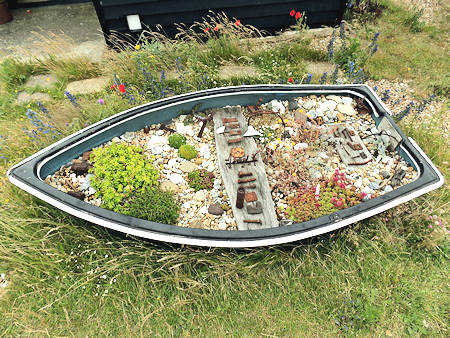
Dungeness Front Garden Display
Lighthouses
There have been five lighthouses at Dungeness since the early 1600s, with the fifth one still fully operational today.
The first lighthouse was built in c1615, but as the shingle banks grew and the sea retreated, a second brick lighthouse , approximately 110ft high was constructed around 1635. This second lighthouse lasted over 100 years, but it too became victim of the increasing shingle banks and was replaced in 1790.
In 1901 Trinity House commissioned Patrick & Co of London to build a new, taller fourth lighthouse, approximately 150 ft high. This lighthouse, now known as The Old Lighthouse, was ceremonially opened by His Majesty, The Prince of Wales, later George V, in 1904. It is still standing and is open to the public during the summer months.
Please visit our Lighthouses History page for more information.
The Old Lighthouse is open for visitors from Easter to October.
Dungeness B Power Station Visitor Centre
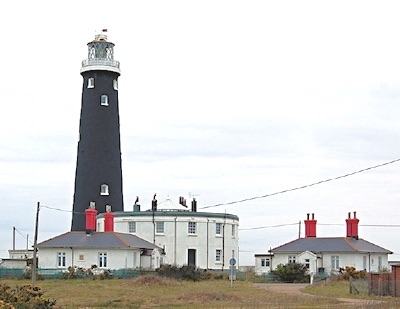
The Old Lighthouse
Dungeness B Power Station has an award winning visitor centre. The centre gives the opportunity for members of the public to enjoy the interactive exhibition zone and embark on a guided site tour to see the plant in operation.
Prospect Cottage
Prospect Cottage was home to Derek Jarman, the well known film director, stage designer, diarist, artist, gardener and author. He is also remembered for his famous shingle cottage-garden, created in the latter years of his life, in the shadow of Dungeness nuclear power station.
The cottage garden was made by arranging flotsam washed up nearby, interspersed with endemic salt-loving beach plants, both set against the bright shingle. The garden has been the subject of several books.
A passionate gardener from childhood, Jarman combined his painter's eye, his horticultural expertise and his ecological convictions to produce a landscape which mixed the flint, shells and driftwood of Dungeness; sculptures made from stones; the area's indigenous plants; and shrubs and flowers introduced by Jarman himself.
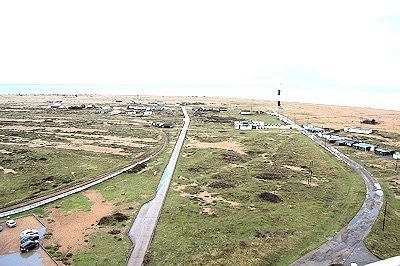
View of Dungeness from the Old Lighthouse
Derek Jarman is buried in the graveyard at St. Clement Church in Old Romney. You can find out more here.
Galleries
There are two galleries at Dungeness, Dungeness Gallery and Dungeness Open Studios.
Photography and Filming on Dungeness
Dungeness is a private estate and a National Nature Reserve and if you are filming or photographing for commercial purposes at Dungeness you must obtain the permission of the Trustees and agree the details beforehand.
If you are simply taking photographs as a hobby or as a holiday snap, then permission is not necessary.
You can find out more here.
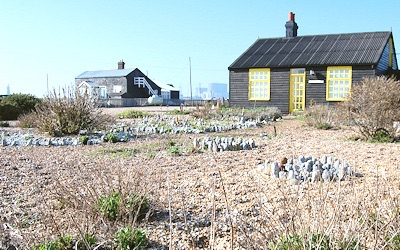
Prosepect Cottage and Garden
In the ruins of the lost village of Dengemarsh, about 1½ miles west of Dungeness Point, lies a concrete man - see picture left. He has been there for over 20 years yet no one knows where he came from or who placed him there.
This area is the old village of Denge which closed when the Lydd ranges opened in WW2. About 50yards further along walking towards the sea lies a memorial to the home of The Prebble family 'Myrtle Cottage' and a few scattered remains of other homes which once stood here, now all lost.
The Concrete Man, a poem by Mary Leadbetter:
The concrete man. I never said that I could win,
I tried and tried and tried.
No one said it was a sin to catch the smugglers on the tide.
I lay there for a hundred days covered in a seaweed bed.
No one saw me switch my gaze until the builders found me dead.
They left me there forevermore piled concrete around my frame.
Don't ask me why it's now folklore, I'm the concrete man without a name.
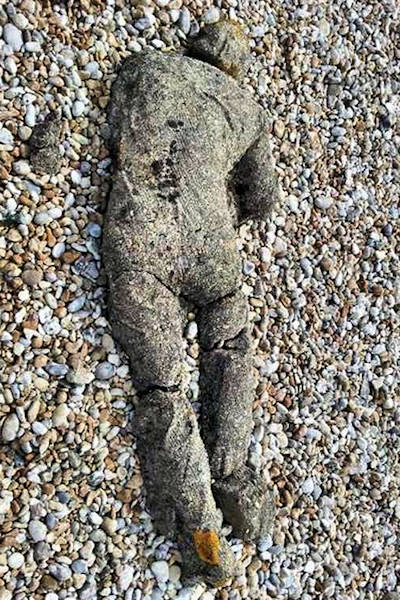
The Concrete Man



